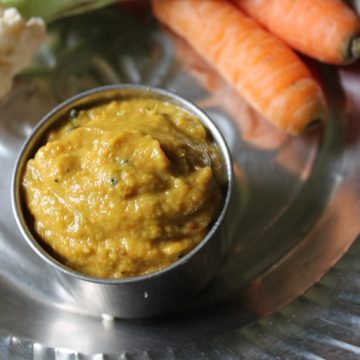Mixed Vegetable Chutney, also known as Veg Chutney, South Indian Veg Thogayal, or Masala Vegetable Dip, is a flavorful and healthy side dish made using a blend of seasonal vegetables, spices, and herbs. This chutney is a perfect way to use leftover veggies like carrots, beans, and cauliflower, and is sauteed with onion, garlic, ginger, green chillies, and tomatoes to enhance the taste.


Vegetable Chutney
After my carrot chutney recipe, i got confidence to try out most wanted recipe which is made with vegetables. I always dreamy of this recipe for a very long time. I wanted to include some kind of vegetables in the chutney so it will make it more tasty and healthy. So i made it and it didn’t even taste that it had vegetables in it. It was so yummy. So try this and let me know how it turned out. Check out my chutney recipes here.
Jump to:
About Vegetable Chutney
This mixed veg chutney recipe is a smart and delicious way to sneak vegetables into your daily meals. Originating from South Indian kitchens where nothing goes to waste, this chutney was first made to use leftover veggies after a harvest festival.
It combines the goodness of vegetables like carrots, beans, cauliflower, and tomatoes with tamarind, ginger, garlic, and green chillies for a bold and tangy kick. Perfect for dosa, idli, or even as a sandwich spread, this healthy chutney for dosa is rich in fiber, vitamins, and flavor.
A spoonful of this vegetable-based chutney brings variety to your breakfast and makes it easy to include veggies in every bite. With its vibrant color and irresistible aroma, this spicy chutney recipe is a must-try for those looking for homemade chutney ideas that are both nutritious and tasty.
Similar Recipes
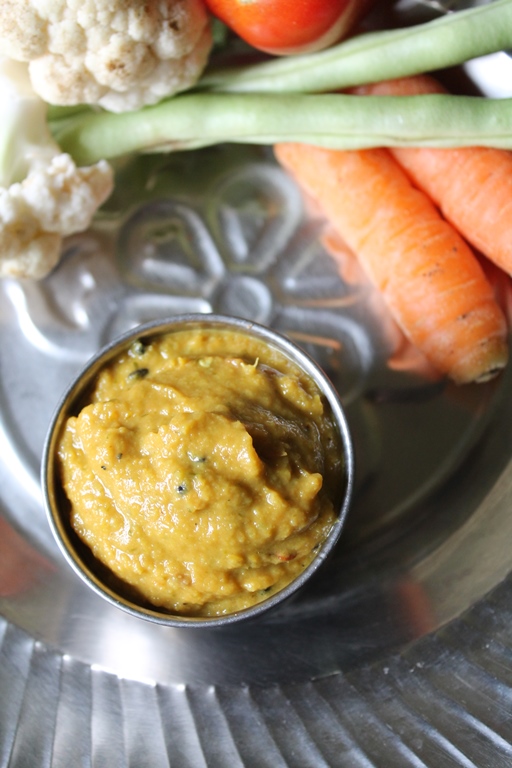

Why this recipe work?
By using veggies like beans, cauliflower, and tomatoes, this recipe adds nutrients while reducing kitchen waste. It’s a great way to add fiber and vitamins without making a separate curry.
Why I love this recipe work – I love how this chutney packs in so many vegetables without anyone even realizing it. Even picky eaters happily enjoy it with dosa or rice. This isn’t just a side dish, it doubles as a sandwich spread, a dip for snacks, or even a curry base. It’s a true multi-tasker in my kitchen.
Whether you like your chutney smooth or chunky, this recipe adapts easily in the blender. The consistency can be customized to suit dosa, idli, chapati, or rice.
Ingredients
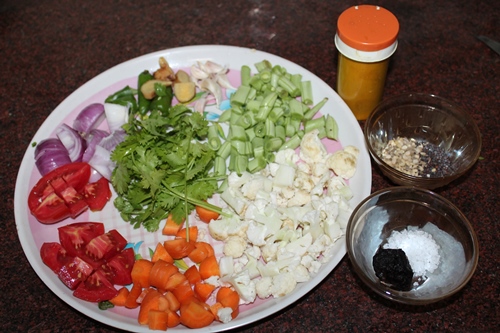

Oil: You can use oil or ghee for the recipe.
Onion: Adds a mild sweetness and depth of flavor when sauteed, forming the base of the chutney.
Green Chilli: Brings heat and sharpness, balancing the sweetness of the vegetables and tamarind.
Ginger & Garlic : Adds warmth and a slight peppery zing that complements the chutney’s earthy flavors.
Tomato: Provides tanginess and moisture, helping to blend all the spices and veggies into a smooth chutney.
Vegetables: I used mixture of carrots, cauliflower, green beans.
Tamarind Pulp: Adds a sharp tang that balances the sweetness of carrots and onions.
Tempering Ingredients – I used mustard, urad dal, cumin, asafoetida, dry red chillies.
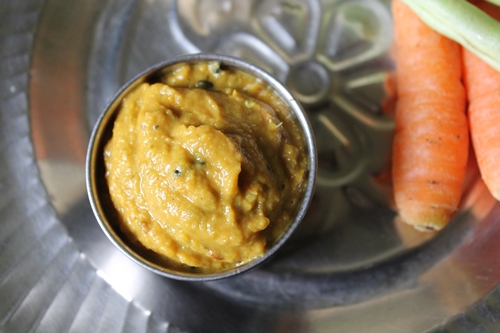

Hacks
Batch Cook and Freeze: Double the recipe and freeze in small portions. Thaw and temper fresh each time to enjoy a ready chutney in minutes.
Add Roasted Dal or Nuts: To make the chutney creamier and protein-rich, blend in 1 tbsp of roasted chana dal or a few cashews/peanuts with the veggies.
Use Frozen Mixed Veggies: Use frozen carrots, beans, and cauliflower instead of chopping fresh ones. Just microwave or steam them before adding.
Serve Warm for Best Taste: Mixed vegetable chutney tastes best when slightly warm or at room temperature. Avoid serving straight from the fridge.
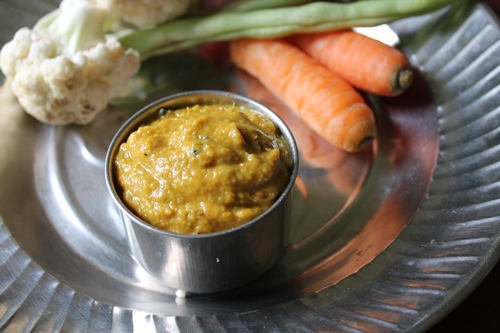

Vegetable Chutney (Step by Step Pictures)
Expert Tips
1. Don’t Overcook the Veggies: Steam or microwave the vegetables just until tender. Overcooking can make the chutney mushy and reduce the fresh flavor.
2. Always Saute the Aromatics First: Cooking onion, garlic, ginger, and green chilli before adding other ingredients builds a deep and flavorful base for the chutney.
3. Use the Vegetable Stock: Don’t discard the water used to steam the vegetables, it contains nutrients and adds extra flavor to the chutney.
4. Let It Cool Before Blending: Blending hot ingredients can affect texture and taste. Cool the mixture slightly to get a smoother and more balanced chutney.
5. Adjust Tamarind and Spice to Taste: Depending on your preference or the sourness of your tamarind pulp, adjust the quantity to balance tanginess with heat and sweetness.
6. Temper Just Before Serving (Optional): If making in advance, do the tempering just before serving to retain its crunch and aroma.
7. Store in Fridge for 3–4 Days: This chutney stays fresh for a few days in an airtight container. Reheat lightly or serve at room temperature for best taste.
8. Add a Spoon of Ghee for Richness (Optional): For a richer flavor, especially when serving with hot rice, mix in a small spoon of ghee before eating.
Variations
Carrot Chutney Recipe: Carrot chutney is a mildly sweet and earthy chutney made with sauteed carrots, garlic, and coconut, blended into a creamy spread. It pairs beautifully with idli, dosa, and even chapati for a nutritious side dish.
Capsicum Chutney Recipe: Capsicum chutney is a flavorful and spicy chutney made using green or red bell peppers, roasted along with onions, chillies, and tamarind. This chutney adds a smoky touch and goes well with breakfast or curd rice.
Beetroot Chutney Recipe: Beetroot chutney is vibrant and rich, blending the sweetness of beets with spices, garlic, and tangy tamarind. It’s a great iron-rich dip that complements dosas, rotis, and rice meals.
Brinjal Chutney Recipe: Brinjal chutney, or kathirikai chutney, is a soft and savory dish made with sautéed brinjal, onions, and spices, blended smooth and tempered for added flavor. It’s a great way to enjoy brinjal in a fuss-free, tasty form.
Ridge Gourd Peel Chutney Recipe: Ridge gourd peel chutney (Peerkangai Thol Thuvaiyal) is a traditional Tamil dish made using the nutritious outer skin of ridge gourd, blended with lentils, tamarind, and green chillies. It’s healthy, eco-friendly, and perfect for hot rice.
Sutta Kathirikai Chutney: Sutta kathirikai chutney is a smoky-flavored brinjal chutney made by roasting whole brinjals over an open flame, peeling the skin, and mashing with spices, onion, and tamarind. It’s rustic, flavorful, and often served with ragi kali or dosa.
FAQ
1)Can I use any vegetables for this chutney?
Yes! While carrots, beans, cauliflower, and tomatoes are commonly used, you can include bottle gourd, capsicum, or even zucchini based on what you have.
2)Can I skip the tempering?
Tempering adds extra flavor and aroma, but you can skip it if you’re in a hurry or want a low-oil version. The chutney still tastes great without it.
3)Can I freeze mixed vegetable chutney?
Yes. Store in freezer-safe containers in small portions. Thaw and do fresh tempering before serving for best taste.
4)What can I serve this chutney with?
It pairs well with dosa, idli, chapati, rice, upma, or even as a sandwich spread or side for parathas.
5)Can I make this chutney without onion and garlic?
Yes, for a no-onion no-garlic version, simply skip them and use more tomatoes and coriander leaves for flavor balance. It still turns out delicious.
6)Why is my chutney tasting bitter?
Overcooked garlic or too much hing can cause bitterness. Always saute gently and use spices in moderation.
More Chutney Recipes
📖 Recipe Card
Vegetable Chutney Recipe
Servings: 6 servings
Calories: 90kcal
Nutrition
Serving: 1servings | Calories: 90kcal | Carbohydrates: 9g | Protein: 2g | Fat: 6g | Saturated Fat: 0.5g | Polyunsaturated Fat: 2g | Monounsaturated Fat: 4g | Trans Fat: 0.02g | Sodium: 23mg | Potassium: 247mg | Fiber: 2g | Sugar: 4g | Vitamin A: 2049IU | Vitamin C: 16mg | Calcium: 30mg | Iron: 1mg
If you have any questions not covered in this post and if you need help, leave me a comment or mail me @[email protected] and I’ll help as soon as I can.
Follow me on Instagram, Facebook,Pinterest ,Youtube and Twitter for more Yummy Tummy inspiration.
IF YOU MAKE THIS RECIPE OR ANYTHING FROM YUMMY TUMMY, MAKE SURE TO POST IT AND TAG ME SO I CAN SEE ALL OF YOUR CREATIONS!! #YUMMYTUMMYAARTHI AND @YUMMYTUMMYAARTHI ON INSTAGRAM!
–>

